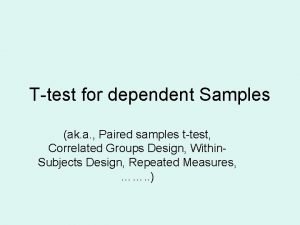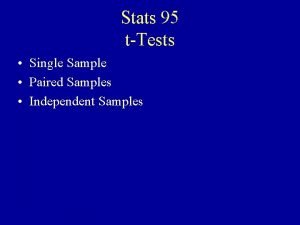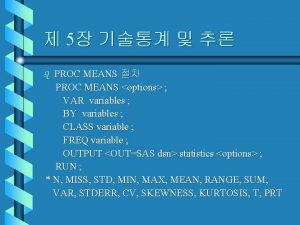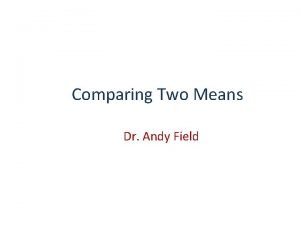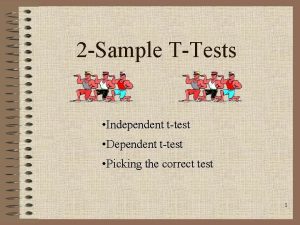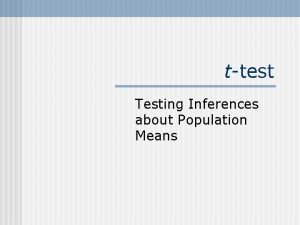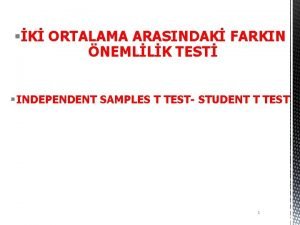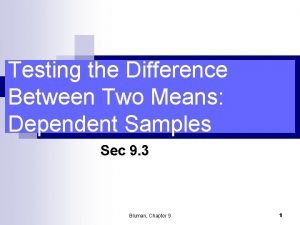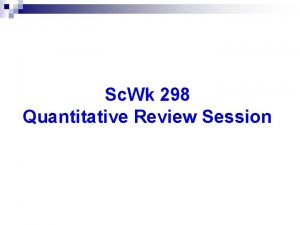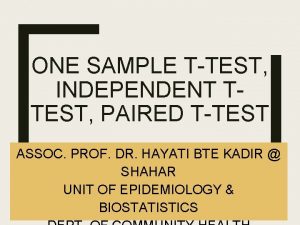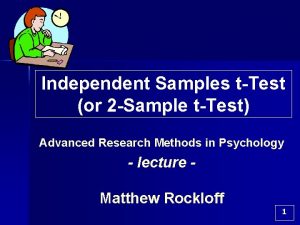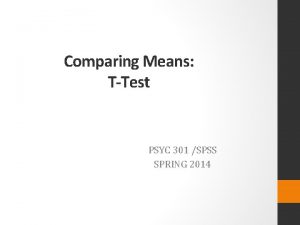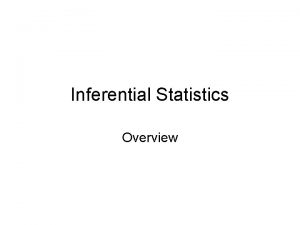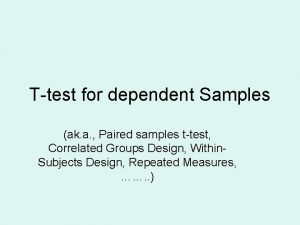Comparing means with SPSS Independent Samples ttest Dr












- Slides: 12

Comparing means with SPSS Independent Samples t-test Dr. Samira M. Mahboub Ph. D Public Health, Alexandria University M. P. H. Public Health, Alexandria University M. B. Ch. B, Faculty of Medicine, Alexandria University FHEA, Higher Education Academy, UK

Independent Samples t-Test • Used to compare means between 2 groups (males vs females, heavy users vs. light users, etc. ) on a characteristic of interest • What’s needed? • A categorical variable (nominal or ordinal) with only 2 response categories (the grouping variable) • One numerical variable (mean score of the characteristic of interest for comparison)

Hypothesis Testing • The statistical test question: • You have 2 means, one for each of the independent groups. • The means will probably be different, but do they differ from each other significantly? • Is this difference due to chance? Or does it represent true differences in the population?

• Example: You want to compare males vs. females (grouping variable) as to income in thousands(test variable)

Using SPSS for Independent Sample t- Test • Analyze>Compare Means>Independent Samples t-Test • Define the grouping variable & tell SPSS your numerical codes for the 2 groups (gender: 1, 2) • The test variable is the dependent variable that you are testing for group differences (yearly income in thousands)

Running Analyses (Independent t- test) 1. Click Analyze- Compare Means- Independent Samples t test 2. Select the test variable and the grouping variable, then click Define Groups 6

Running Analyses (Independent t- test) 3. Label the groups (in this case f or m) 4. Select OK 7

Running Analyses (Independent t- test) The results will appear 8

Levene’s Test of Equality of Variances • First check Levene’s Test of Equality of Variances to see if you use the t-test scores for equal variances or unequal variances • Variance measures how far a data set is spread out. A value of zero means that there is no variability; All the numbers in the data set are the same. •

Levene’s Test of Equality of Variances • Look at Sig (p-value) associated with the Levene’s test • If p >. 05 for the F score on this test, assume equal variances and read the TOP line t value, df, and sig. • If p <. 05 for the F score on this test, assume unequal variances and read the BOTTOM line t value, df, and sig.

Conclusion • After determining which t-test output to use, look at Sig (p value) of the t value • The conclusion here? • descriptive: M = 70. 16 vs. F = 68. 77 thousands • There is NOT a significant difference in yearly income between males and females (t = 0. 702, df = 6398, p =. 483).

Try it NOW • Conduct 2 independent samples t test on the given data • State value of t & p • Write your comment
 T test for dependent samples formula
T test for dependent samples formula Varianzanalyse
Varianzanalyse Formula for paired sample t test
Formula for paired sample t test Proc ttest
Proc ttest Between subjects vs within subjects
Between subjects vs within subjects Ttest ind
Ttest ind Graphpad ttest
Graphpad ttest Formula for t test independent samples
Formula for t test independent samples Successive independent samples design
Successive independent samples design Median
Median Student t testi
Student t testi Testing the difference between two means dependent samples
Testing the difference between two means dependent samples Wk 298
Wk 298
